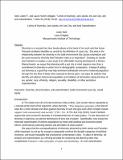Limits of diversity: Jane Jacobs, the Just City, and anti-subordination
Author(s)
Steil, Justin P; Delgado, Laura Humm
DownloadAccepted version (509.9Kb)
Publisher with Creative Commons License
Publisher with Creative Commons License
Creative Commons Attribution
Terms of use
Metadata
Show full item recordAbstract
Diversity is a concept that Jane Jacobs places at the heart of her work and that Susan Fainstein similarly identifies as central to the definition of a just city. But what is the relationship between the diversity in the built environment that Jacobs emphasizes and the socio-economic diversity that Fainstein notes is so important? Drawing on Jacobs and Fainstein to analyze a case study of an affordable housing development in Boston, Massachusetts, we argue that planning with a just city in mind requires more than a commitment to diversity in urban form or demographic composition. Instead of setting out diversity as a goal that may help dominant individuals overcome irrational prejudices through the free flow of ideas when exposed to diverse peers, we argue for policies that identify and address historical inequalities and relations of domination along the lines of sex, sexuality, race, ethnicity, national origin, or other ascriptive characteristics.
Date issued
2019-08Department
Massachusetts Institute of Technology. Department of Urban Studies and PlanningJournal
Cities
Publisher
Elsevier BV
Citation
Steil, Justin P. and Laura Humm Delgado. "Limits of diversity: Jane Jacobs, the Just City, and anti-subordination." Cities 91 (August 2018): 39-48 © 2018 Elsevier Ltd
Version: Author's final manuscript
ISSN
0264-2751